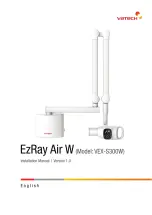
Subject to change without notice
30
For greatest accuracy adjust the time base for slightly over
one period and approximately the same height of both signals
on the screen. The Y deflection coefficients, the time base
coefficients and the trigger level setting can be used for this
adjustment, without influence on the result. Both base lines
are set onto the horizontal graticule center line using the
Y-
POS.
knobs before the measurement. With sinusoidal signals,
observe the zero (crossover point) transitions; the sine peaks
are less accurate. If a sine signal is noticeably distorted by
even harmonics, or if a
DC
voltage is present,
AC
coupling is
recommended for both channels. If it is a question of pulses
of the same shape, read off at steep edges.
It must be noted that the phase difference cannot be deter-
mined if alternate triggering is selected.
Phase difference measurement in DUAL mode
t
= horizontal spacing of the zero transitions in div
T
= horizontal spacing for one period in div
In the example illustrated, t = 3div and T = 10div.
The phase difference in degrees is calculated from
Relatively small phase angles at not too high frequencies can
be measured more accurately in the X-Y mode with Lissajous
figures.
Measurement of an
amplitude modulation
The momentary amplitude u at time t of a HF-carrier voltage,
which is amplitude modulated without distortion by a
sinusoidal AF voltage, is in accordance with the equation
where
UT
= unmodulated carrier amplitude
Ω
Ω
Ω
Ω
Ω
= 2
π
F = angular carrier frequency
ω
ω
ω
ω
ω
= 2
π
f = modulation angular frequency
m
= modulation factor.
The lower side frequency
F-f
and the upper side frequency
F+f
arise because of the modulation apart from the carrier
frequency F.
The display of an amplitude-modulated HF oscillation can be
evaluated with the oscilloscope provided the frequency
spectrum is inside the oscilloscope bandwidth. The time base
is set so that several cycles of the modulation frequency are
visible. Strictly speaking, triggering should be external with
modulation frequency (from the AF generator or a demo-
dulator). However, internal triggering is frequently possible
with normal triggering using a suitable trigger level setting
and possibly also using the time vernier (variable) adjustment.
Figure 1
Amplitude and frequency spectrum for AM display (m = 50%)
Oscilloscope setting for a signal according to figure 2:
• Y: CH. I; 20mV/div; AC.
• TIME/DIV.: 0.2ms/div.
• Triggering: Normal; with LEVEL-setting; internal
(or external) triggering.
Figure 2
Amplitude modulated oscillation: F = 1 MHz; f = 1 kHz;
m = 50 %; UT = 28.3 mV rms.
If the two values a and b are read from the screen, the
modulation factor is calculated from
where
a = UT (1+m)
and
b = UT (1-m)
.
The variable controls for amplitude and time can be set
arbitrarily in the modulation factor measurement. Their
position does not influence the result.
Triggering and time base
All controls regarding trigger and time base are located on
the right of the VOLTS/DIV. knobs. They are described in the
section
“Controls and Readout”
.
Time related amplitude changes on a measuring signal (AC
voltage) are displayable in Yt-mode. In this mode the signal
voltage deflects the beam in vertical direction (Y) while the
time base generator moves the beam from the left to the
right of the screen (time deflection = t).
Normally there are periodically repeating waveforms to be
displayed. Therefore the time base must repeat the time
deflection periodically too. To produce a stationary display,
the time base must only be triggered if the signal height and
slope condition coincide with the former time base start
conditions. A DC voltage signal can not be triggered as it is a
constant signal with no slope.
Triggering can be performed by the measuring signal itself
(internal triggering) or by an external supplied but synchronous
voltage (external triggering).
The trigger voltage should have a certain minimum amplitude.
This value is called the trigger threshold. It is measured with
Operating modes of the vertical amplifiers in Yt mode













































